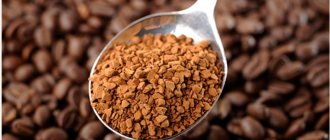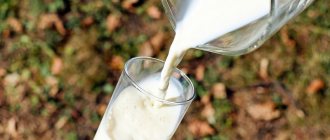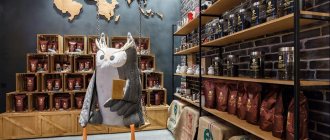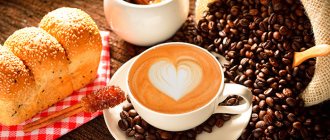Good afternoon, We continue to write about life hacks in our kitchen. Today we will answer the question, how many grams of flour are in a mug and cup. Everyone knows that flour is usually measured in glasses or spoons. But sometimes it also happens that there is no glass available. Tell me that this cannot happen? Honestly, we saw the truth with the bachelor, but there may also be other options. But if you still have a glass available, then it is better to measure the flour with a glass. All the data on our website is how many grams of flour are in a glass. When you only have a mug or cup, you can get by with that. You just need to know how big your mug or cup is.
Mugs and cups are different, but it is generally accepted that a regular mug contains 250 ml, since a mug of tea is never filled to the brim. And if you fill an ordinary mug to the brim, the volume of an ordinary mug will be 300 ml. But the American cup (USA) holds a volume of 236.58 milliliters, which is approximately 240 ml. But again, if you don’t top it up, it will be about 200 ml. There are also non-standard mugs with a volume of 350, 400, 450 and 500 ml. See below (table).
How many grams are in 300 ml of water?
At the end of the page, be sure to look at the information about the volume of dishes used in this calculation. Background information - 300 ml water
this is
300 grams
.
Interesting materials:
What is a navigator on an airplane? Who is Skakar in thieves' jargon? Who is a supplier in a company? Who is a subject in social science? Who is Tarantiev and his role in Oblomov’s fate? Who is a person liable for military service in Kazakhstan? Who works in agriculture? Who will kill Rollo? Who taught Pyotr Grinev to read and write? Who teaches Pyotr Grinev fencing?
Foreign weights
My husband and I often like to look at foreign sites about food and take some recipes into service, but there is a small catch - they have different weight measures. For example, in addition to quarts, pints and ounces, they do not measure in glasses; instead they use cups, which, you see, is not usual for us and cannot be compared in any way with the volume of our glass. Therefore, we present foreign weight measures.
American volume measures
| 1 cup | 250 ml |
| 1/4 cup | 60 ml |
| 1/2 cup | 125 l |
| 2/3 cup | 170 ml |
| 3/4 cup | 190 ml |
| 1 tsp (1 tsp) | 5 ml |
| 1 tbsp. (1 tbsp) | 15 ml |
| 1 pint | 470 ml |
| 1 quart (1 qt, qwart) | 950 ml |
| 1 fl. oz. (1 fl. oz.) | 30 ml |
English volume measures
| 1 cup | 280 ml |
| 1 tsp (1 tsp) | 6 ml |
| 1 tbsp. (1 tbsp) | 17 ml |
| 1 pint | 570 ml |
| 1 quart (1 qt, qwart) | 1100 ml |
Weights
| 1 ounce (1 ounce) | 28.3 g |
| 1 pound | 450 g |
Where else are these containers used?
In addition to their intended purpose, mugs are also used in the preparation of various dishes as measuring cups or for storing flour, sugar or cereals. Many housewives have decorative vessels in their kitchens in which they hold cutlery. Speaking about this use of mugs, it is worth noting that often their capacity is at least 500 ml. They can be decorated with decorative elements and are not designed for storing liquids. There are also products that can easily be put on fire without fear of deformation.
Liter containers can be used as flower pots or vases. The use of such metal or glass mugs depends on your imagination and imagination. True, the price of such items can be much higher than their counterparts for their intended purpose. Therefore, if you have an old metal or glass mug lying around, do not rush to get rid of it. Perhaps it will fit perfectly into the interior of the kitchen or living room.
In general, we can say that the direct purpose and relevance of use will be directly proportional to how many ml are in the mug, and the second criterion for choosing this product will be the material and color
The price will also be important, because for some this type of dishes is a trifle, while others like to sit down in bad weather with their favorite mug and an interesting book, covered with a warm blanket
What data is needed?
To calculate the capacity of a pool, basic geometric rules are applied. Given the round shape of the bowl, the interior space can be imagined as a perfect cylinder.
For calculations you will need 3 quantities:
- depth;
- diameter or radius;
- constant π = 3.14.
The depth is not taken to be the height of the sides, but the water level in the pool. There are structures where water constantly overflows, but in most cases the sides will be 15-20 cm higher.
It is assumed that the depth of the pool is the same throughout its entire area. If this is not the case, you can take the average value for rough calculations.
Reference. If it is not possible to know the diameter of the pool, you can use a tape measure to measure the length of its circumference Lcr along the inside of the edge. Then use the formula for calculating the diameter: D=Lokr/ 3.14.
500, 600, 700 grams of flour - how much?
Today we will measure 500, 600, 700 grams of flour using a glass and a spoon. Of course, it is easiest to measure such a large volume of flour with glasses, but this is also possible with ordinary tablespoons. In order to start calculations, you need to know how many grams of flour are in 1 250 ml glass (aka faceted) and in a tablespoon and a teaspoon. See table below.
| In cutlery | Gram |
| in a glass (250 ml) | 160 grams |
| in a glass (200 ml) | 130 grams |
| in a tablespoon | 30 grams (with a large slide) 15 grams (without a slide) |
| in a dessert spoon | 20 grams (with a large slide) 10 grams (without a slide) |
| in a teaspoon | 10 grams (with a large slide) 5 grams (without a slide) |
How can you measure the weight of food?
- scales
- steelyard
- measuring cup
- measuring spoon (jug) with electronic scales
- teaspoon
- tablespoon
- faceted glass
- thin-walled glass
- a special set of measuring spoons (you can even buy them at Fix Price)
Show slideshow
Volume of other glasses
After conducting a mini-research on custom glasses, we discovered two golden rules:
1. If the glass has a rim , then you need to fill it to the rim - then you get 200 ml
2. A glass without a rim - you need to fill it to the top - then you get 200 ml
But there can be exceptions to any rule, therefore, if in everyday life you use glasses other than standard faceted glasses, then we advise you to measure their volume once. This information will definitely come in handy when preparing dishes, even if you have scales at hand.
As practice shows, frequent work with scales quickly gets boring; moreover, in home recipes, products are often measured by volume rather than by weight - this makes scales useless in many cases.
How to measure the volume of a glass
The easiest way to measure the volume of a glass is to pour water into it from a measuring cup.
But you can more accurately determine the volume only with the help of scales.
First, set the scale to measure in grams .
If your scales have a zero correction function or “tare compensation” (all electronic scales have them), then you can immediately get the weight of water poured to the rim and to the top .
If there is no zero correction, then: – first weigh the empty glass ( 1 ), – then fill it with water to the rim , weigh ( 2 ); – then fill to the top , weigh again ( 3 ).
From the obtained values in grams ( 2 and 3 ), you need to subtract the weight of the glass itself ( 1 ).
The result will be the net weight of the water poured, which will exactly correspond to the volume of the glass, expressed in milliliters (ml).
Table of weights and measures for milk
Knowing the difference in the specific gravity of a dairy product and water allows you to calculate how much a liter of dairy product weighs. If 5 ml of it weigh 5.1 g, then 1000 ml have a mass of 1 kg 20 g (1000: 5 = 200; 5.1x200 = 1020). You can make a table of measures and weights.
| Volume (ml) | Number of items l. | Quantity of tea. l. | How many grams |
| 500 | 33 | 100 | 510 |
| 300 | 20 | 60 | 306 |
| 250 | 17 | 50 | 255 |
| 200 | 13 | 40 | 204 |
| 150 | 10 | 30 | 153 |
| 100 | 7 | 20 | 102 |
| 50 | 3 | 10 | 51 |
| 30 | 2 | 6 | 30.6 |
| 25 | 2 | 5 | 25.5 |
| 15 | 1 | 3 | 15.3 |
| 10 | — | 2 | 10.2 |
| 5 | — | 1 | 5.1 |
How big are the circles (available in stores)?
By visiting the nearest supermarket or a themed online store of tableware, you can find a wide selection of mugs on sale, the volume of which varies greatly from each other:
- 60 ml (small espresso mug).
- 90 ml.
- 100 ml.
- 110 ml (coffee mugs and saucers).
- 120 ml (coffee mugs and saucers).
- 140 ml (coffee mugs and saucers).
- 150 ml (coffee mugs and saucers).
- 200 ml.
- 220 ml.
- 250 ml (the volume of a standard tea mug, for example: IKEA brand (IKEA)).
- 300 ml (usually these are white mugs, regular cylindrical in shape with a handle, on which various prints or designs are applied).
- 320 ml (transparent mug with handle, for example: Luminarc brand).
- 330 ml.
- 340 ml.
- 360 ml.
- 390 ml.
- 450 ml.
- 550 ml.
- 600 ml.
- 850 ml (large ceramic gift mugs with bright prints and more).
What is the capacity of coffee cups?
So, in Russia, it is generally accepted that a cup
designed for 100-130 ml of coffee, in the USA they like to use larger mugs - from 140 to 180 ml.
This applies specifically to the coffee cup
!
Interesting materials:
How much milk is needed to make 1 liter of cream? How long do you need to work to get normal maternity leave? How long do you need to work to receive a northern pension? How long do you need to live in Greece to obtain citizenship? How much service do you need to receive the minimum pension? How long does it take to get a black belt? How much pension can a widow of a military pensioner receive? How many pension points are needed to receive a pension? How much does an auditor earn in Moscow? How much does a business analyst earn?











